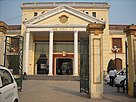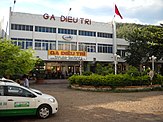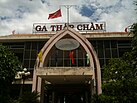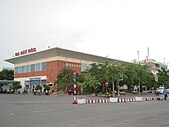North–South railway (Vietnam)
| North–South railway | |||||||||||||||||||||||||||||||||||||||||||||||||||||||||||||||||||||||||||||||||||||||||||||||||||||||||||||||||||||||||||||||||||||||||||||||||||||||||||||||||||||||||||||||||||||||||||||||||||||||||||||||||||||||||||||||||||||||||||||||||||||||||||||||||||||||||||||||||||||||||||||||||||||||||||||||||||||||||||||||||||||||||||||||||||||||||||||||||||||||||||||||||||||||||||||||||||||||||||||||||||||||||||||||||||||||||||||||||||||||||||||||||||||||||||||||||||||||||||||||||||||||||||||||||||||||||||||||||||||||||||||||||||||||||||||||||||||||||||||||||||||||||||||||||||||||||||||||||||||||||||||||||||||||||||||||||||||||||||||||||||||||||||||||||||||||||||||||||||||||||||||||||||||||||||||||||||||||||||||||||||||||||||||||||||||||||||||||||||||||||||||||||||||||||||||||||||||||||||||||||||||||||||||||||||||||||||||||||||||||||||||||||||||||||||||||||||||||||||||||||||||||||||||||||||||||||||||||||||||||||||||||||||||||||||||||||||||||||||||||||||||||||||||||||||||||||||||||||||||||
|---|---|---|---|---|---|---|---|---|---|---|---|---|---|---|---|---|---|---|---|---|---|---|---|---|---|---|---|---|---|---|---|---|---|---|---|---|---|---|---|---|---|---|---|---|---|---|---|---|---|---|---|---|---|---|---|---|---|---|---|---|---|---|---|---|---|---|---|---|---|---|---|---|---|---|---|---|---|---|---|---|---|---|---|---|---|---|---|---|---|---|---|---|---|---|---|---|---|---|---|---|---|---|---|---|---|---|---|---|---|---|---|---|---|---|---|---|---|---|---|---|---|---|---|---|---|---|---|---|---|---|---|---|---|---|---|---|---|---|---|---|---|---|---|---|---|---|---|---|---|---|---|---|---|---|---|---|---|---|---|---|---|---|---|---|---|---|---|---|---|---|---|---|---|---|---|---|---|---|---|---|---|---|---|---|---|---|---|---|---|---|---|---|---|---|---|---|---|---|---|---|---|---|---|---|---|---|---|---|---|---|---|---|---|---|---|---|---|---|---|---|---|---|---|---|---|---|---|---|---|---|---|---|---|---|---|---|---|---|---|---|---|---|---|---|---|---|---|---|---|---|---|---|---|---|---|---|---|---|---|---|---|---|---|---|---|---|---|---|---|---|---|---|---|---|---|---|---|---|---|---|---|---|---|---|---|---|---|---|---|---|---|---|---|---|---|---|---|---|---|---|---|---|---|---|---|---|---|---|---|---|---|---|---|---|---|---|---|---|---|---|---|---|---|---|---|---|---|---|---|---|---|---|---|---|---|---|---|---|---|---|---|---|---|---|---|---|---|---|---|---|---|---|---|---|---|---|---|---|---|---|---|---|---|---|---|---|---|---|---|---|---|---|---|---|---|---|---|---|---|---|---|---|---|---|---|---|---|---|---|---|---|---|---|---|---|---|---|---|---|---|---|---|---|---|---|---|---|---|---|---|---|---|---|---|---|---|---|---|---|---|---|---|---|---|---|---|---|---|---|---|---|---|---|---|---|---|---|---|---|---|---|---|---|---|---|---|---|---|---|---|---|---|---|---|---|---|---|---|---|---|---|---|---|---|---|---|---|---|---|---|---|---|---|---|---|---|---|---|---|---|---|---|---|---|---|---|---|---|---|---|---|---|---|---|---|---|---|---|---|---|---|---|---|---|---|---|---|---|---|---|---|---|---|---|---|---|---|---|---|---|---|---|---|---|---|---|---|---|---|---|---|---|---|---|---|---|---|---|---|---|---|---|---|---|---|---|---|---|---|---|---|---|---|---|---|---|---|---|---|---|---|---|---|---|---|---|---|---|---|---|---|---|---|---|---|---|---|---|---|---|---|---|---|---|---|---|---|---|---|---|---|---|---|---|---|---|---|---|---|---|---|---|---|---|---|---|---|---|---|---|---|---|---|---|---|---|---|---|---|---|---|---|---|---|---|---|---|---|---|---|---|---|---|---|---|---|---|---|---|---|---|---|---|---|---|---|---|---|---|---|---|---|---|---|---|---|---|---|---|---|---|---|---|---|---|---|---|---|---|---|---|---|---|---|---|---|---|---|---|---|---|---|---|---|---|---|---|---|---|---|---|---|---|---|---|---|---|---|---|---|---|---|---|---|---|---|---|---|---|---|---|---|---|---|---|---|---|---|---|---|---|---|---|---|---|---|---|---|---|---|---|---|---|---|---|---|---|---|---|---|---|---|---|---|---|---|---|---|---|---|---|---|---|---|---|---|---|---|---|---|---|---|---|---|---|---|---|---|---|---|---|---|---|---|---|---|---|---|---|---|---|---|---|---|---|---|---|---|---|---|---|---|---|---|---|---|---|---|---|---|---|---|---|---|---|---|---|---|---|---|---|---|---|---|---|---|---|---|---|---|---|---|---|---|---|---|---|---|---|---|---|---|---|---|---|---|---|---|---|---|---|---|---|---|---|---|---|---|---|---|---|---|---|---|---|---|---|---|---|---|---|---|---|---|---|---|---|---|---|---|---|---|---|---|---|---|---|---|---|---|---|---|---|---|---|---|---|---|---|---|---|---|---|---|---|---|---|---|---|---|---|---|---|---|---|---|---|---|---|---|---|---|---|---|---|---|---|---|---|---|---|---|---|---|---|---|---|---|---|---|---|---|---|---|---|---|---|---|---|---|---|---|---|---|---|---|---|---|---|---|---|---|---|---|---|---|---|---|---|---|---|---|---|---|---|---|---|---|---|---|---|---|---|---|---|---|---|---|---|---|---|---|---|---|---|---|---|---|---|---|---|---|---|---|---|---|---|---|---|
ETCS Level 2 | |||||||||||||||||||||||||||||||||||||||||||||||||||||||||||||||||||||||||||||||||||||||||||||||||||||||||||||||||||||||||||||||||||||||||||||||||||||||||||||||||||||||||||||||||||||||||||||||||||||||||||||||||||||||||||||||||||||||||||||||||||||||||||||||||||||||||||||||||||||||||||||||||||||||||||||||||||||||||||||||||||||||||||||||||||||||||||||||||||||||||||||||||||||||||||||||||||||||||||||||||||||||||||||||||||||||||||||||||||||||||||||||||||||||||||||||||||||||||||||||||||||||||||||||||||||||||||||||||||||||||||||||||||||||||||||||||||||||||||||||||||||||||||||||||||||||||||||||||||||||||||||||||||||||||||||||||||||||||||||||||||||||||||||||||||||||||||||||||||||||||||||||||||||||||||||||||||||||||||||||||||||||||||||||||||||||||||||||||||||||||||||||||||||||||||||||||||||||||||||||||||||||||||||||||||||||||||||||||||||||||||||||||||||||||||||||||||||||||||||||||||||||||||||||||||||||||||||||||||||||||||||||||||||||||||||||||||||||||||||||||||||||||||||||||||||||||||||||||||||||
| Maximum incline | ≤6‰/≤9‰ | ||||||||||||||||||||||||||||||||||||||||||||||||||||||||||||||||||||||||||||||||||||||||||||||||||||||||||||||||||||||||||||||||||||||||||||||||||||||||||||||||||||||||||||||||||||||||||||||||||||||||||||||||||||||||||||||||||||||||||||||||||||||||||||||||||||||||||||||||||||||||||||||||||||||||||||||||||||||||||||||||||||||||||||||||||||||||||||||||||||||||||||||||||||||||||||||||||||||||||||||||||||||||||||||||||||||||||||||||||||||||||||||||||||||||||||||||||||||||||||||||||||||||||||||||||||||||||||||||||||||||||||||||||||||||||||||||||||||||||||||||||||||||||||||||||||||||||||||||||||||||||||||||||||||||||||||||||||||||||||||||||||||||||||||||||||||||||||||||||||||||||||||||||||||||||||||||||||||||||||||||||||||||||||||||||||||||||||||||||||||||||||||||||||||||||||||||||||||||||||||||||||||||||||||||||||||||||||||||||||||||||||||||||||||||||||||||||||||||||||||||||||||||||||||||||||||||||||||||||||||||||||||||||||||||||||||||||||||||||||||||||||||||||||||||||||||||||||||||||||||
| |||||||||||||||||||||||||||||||||||||||||||||||||||||||||||||||||||||||||||||||||||||||||||||||||||||||||||||||||||||||||||||||||||||||||||||||||||||||||||||||||||||||||||||||||||||||||||||||||||||||||||||||||||||||||||||||||||||||||||||||||||||||||||||||||||||||||||||||||||||||||||||||||||||||||||||||||||||||||||||||||||||||||||||||||||||||||||||||||||||||||||||||||||||||||||||||||||||||||||||||||||||||||||||||||||||||||||||||||||||||||||||||||||||||||||||||||||||||||||||||||||||||||||||||||||||||||||||||||||||||||||||||||||||||||||||||||||||||||||||||||||||||||||||||||||||||||||||||||||||||||||||||||||||||||||||||||||||||||||||||||||||||||||||||||||||||||||||||||||||||||||||||||||||||||||||||||||||||||||||||||||||||||||||||||||||||||||||||||||||||||||||||||||||||||||||||||||||||||||||||||||||||||||||||||||||||||||||||||||||||||||||||||||||||||||||||||||||||||||||||||||||||||||||||||||||||||||||||||||||||||||||||||||||||||||||||||||||||||||||||||||||||||||||||||||||||||||||||||||||||
The North–South railway (
From World War II through to the Vietnam War, the entire North–South railway sustained major damage from bombings and sabotage.[5] Owing to this damage, and to a subsequent lack of capital investment and maintenance, much of the infrastructure along the North–South railway remains outdated or in poor condition; in turn, lack of infrastructure development has been found to be a root cause for railway accidents along the line, including collisions at level crossings and derailments. Recent rehabilitation projects, supported by official development assistance, have improved the safety and efficiency of the line. As of 2007, 85% of the network's passenger volume and 60% of its cargo volume was transported along the line.[6] The national railway company, Vietnam Railways, owns and operates the line.
Overview

For the most part, this 1,726 km (1,072 mi) long
As of 2007, 85% of the network's passenger traffic and 60% of its cargo traffic was transported along the North–South line, corresponding to 3,960.6 million person-km and 2,329.5 million ton-km, respectively.[nb 1] These proportions are only slightly different from those recorded in the early 1990s; 1993 figures reported 82% of passenger traffic and 66% of cargo traffic along the line.[6]
Passenger service
Daily passenger service is provided along the entire North–South railway by state railway company Vietnam Railways. Express service links Hanoi and Ho Chi Minh City, making stops at major stations; local service is also provided along shorter portions of the line, such as from Hanoi to Vinh, Vinh to Đồng Hới, Vinh to Quy Nhon, and so on. The following trains run regularly along the line (each line represents a pair of trains, one southbound and the other northbound):[9]
| Train | Type | From | To | Length | Notes |
|---|---|---|---|---|---|
| SE1/SE2 | Express | Hanoi | Ho Chi Minh City | 34 hrs, 40 mins | Stops at Nam Định, Thanh Hóa, Vinh, Đồng Hới, Dong Ha, Huế, Lang Co, Da Nang, Tam Ky, Quảng Ngãi, Dieu Tri, Tuy Hòa, Nha Trang, Thap Cham, Muong Man |
| SE3/SE4 | Express | Hanoi | Ho Chi Minh City | 29 hrs, 30 mins | Stops at Vinh, Đồng Hới, Huế, Da Nang, Dieu Tri, Nha Trang |
| SE5/SE6 | Express | Hanoi | Ho Chi Minh City | 32 hrs | Stops at Phủ Lý, Nam Định, Ninh Bình, Thanh Hóa, Vinh, Đồng Hới, Huế, Da Nang, Quảng Ngãi, Dieu Tri, Nha Trang, Thap Cham, Muong Man, Bien Hoa |
| TN1/TN2 | Local | Hanoi | Ho Chi Minh City | 40 hrs, 50 mins | |
| TN3/TN4 | Local | Hanoi | Ho Chi Minh City | 40 hrs, 45 mins | |
| TN5/TN6 | Local | Hanoi | Ho Chi Minh City | 40 hrs, 10 mins | |
| TN7/TN8 | Local | Hanoi | Ho Chi Minh City | 40 hrs, 25 mins | |
| NA1/NA2 | Local | Hanoi | Vinh | ||
| NA3/NA4 | Local | Hanoi | Vinh | ||
| TH1/TH2 | Local | Giap Bat | Thanh Hóa | ||
| VD31/VD32 | Local | Vinh | Đồng Hới | OUT OF SERVICES | |
| DH41/DH42 | Local | Đồng Hới | Huế | OUT OF SERVICES | |
| VQ1/VQ2 | Local | Vinh | Quy Nhon |
Freight service
Vietnam Railways provides daily freight transport, mainly between Hanoi and Ho Chi Minh City; freight service ending at Da Nang is also offered. The following trains run regularly along the line (each line represents a pair of trains, one southbound and the other northbound):[10]
| Train | From | To | Notes |
|---|---|---|---|
| GS1/GS2 | Giáp Bát (Hanoi) | Sóng Thần (HCMC) | 4-day itinerary |
| SBN1/SBN2 | Giáp Bát (Hanoi) | Sóng Thần (HCMC) | 4-day itinerary |
| HBN1/HBN2 | Giáp Bát (Hanoi) | Sóng Thần (HCMC) | |
| HBN3/HBN4 | Giáp Bát (Hanoi) | Sóng Thần (HCMC) | |
| ASY1/ASY2 | Giáp Bát (Hanoi) | Sóng Thần (HCMC) | |
| AH1/AH2 | Giáp Bát (Hanoi) | Sóng Thần (HCMC) | |
| HSD1/HSD2 | Da Nang | Ho Chi Minh City | |
| HSK1/HSK2 | Kim Lien (Da Nang) | Sóng Thần (HCMC) | |
| 4 digits number | Giáp Bát (Hanoi) | Sóng Thần (HCMC) |
History

In 1895, outgoing
Construction of the first sections of the North–South railway itself began in 1899, and lasted over thirty years, with individual sections completed serially. The first section to be laid down was the Hanoi–Vinh section, built from 1899 to 1905. Next to be built was the Nha Trang–Saigon section from 1905 to 1913; the Saigon–Tan Linh portion was opened in 1908, followed by the Tan Linh–Nha Trang portion in 1913. During this time, tracks were also laid around the city of Huế, leading south to Tourane, and north to Đông Hà. The Huế–Tourane section opened in 1906, and the Huế–Dong Ha line opened in 1908. The Vinh-Huế section was constructed from 1913 to 1927, and finally, the remaining Huế–Nha Trang section was constructed from 1930 to 1936.[2][6][11] On 2 October 1936, the entire 1,726 km (1,072 mi) Hanoi–Saigon link was formally put into full operation.
As elsewhere in the world, the railways were the sites of active union and labor organization.[14]
The first journeys from end to end of the newly completed line, dubbed the Transindochinois ("Trans-Indochinese"), generally took about 60 hours, or two days and three nights.[15] This decreased to about 40 hours by the late 1930s, with trains travelling at an average speed of 43 km/h (27 mph).[5] Trains were generally pulled by French Pacific or Mikado locomotives, and included dining cars and sleeping cars (voitures-couchettes).[12]
Wartime
After the Japanese invasion of French Indochina during World War II, Japanese forces used the Vietnamese railway system extensively, inviting sabotage by the Viet Minh as well as American bombing from the air. Following the exit of the Japanese at the end of the war, efforts were made to repair the seriously damaged North–South line.
Shortly after World War II ended, however, the

Throughout the Vietnam War, the North–South railway was a target of bombardments and sabotage by both North Vietnamese and South Vietnamese forces. The South, supported with the United States, reconstructed the track between Saigon and Huế in the late 1950s, a distance of 1,041 km (647 mi). Nevertheless, a relentless campaign of intense bombing and sabotage by the Viet Cong and North Vietnamese regular units resulted in the South Vietnamese railway system being unable to carry significant tonnages. 795 attacks were launched between 1961 and 1964 alone, eventually forcing the South to abandon many large sections of the track.[5] The U.S. Army operating in South Vietnam had considerable interest in the North–South line because of the potential it offered in the bulk movement of cargo at low rates. The system was used to support the Military Assistance Command, Vietnam, construction program and transported hundreds of thousands of tons of rock and gravel to air base and highway sites.[21]
In North Vietnam, American bombing of railways was concentrated on key targets such as railway bridges, both along the North–South railway and along the lines north of Hanoi, such as the Hanoi–Lào Cai and Hanoi–Dong Dang lines. Operation Rolling Thunder was the first large-scale bombing campaign carried out by the U.S. Air Force, taking place from March 2, 1965 until November 1, 1968, when US President Lyndon B. Johnson temporarily called off air raids. Large-scale air raids resumed from May 9 to October 23, 1972, for Operation Linebacker, and again from December 18–29, 1972, for Operation Linebacker II, with fewer target restrictions than Rolling Thunder.
A particularly difficult target for the U.S. Air Force was the
After the
Accidents and incidents
On 10 March 2015
On 7 August 2023, rocks collapsed at km 455 in Quang Binh in a tunnel, leading to massive delays (up to 16 hours 26 minutes). This happened during maintenance of the tunnel.[25]
Stations
List of stations
This abridged list includes all major stations[nb 3] with timetabled services. As of 2005, there were 278 stations on the Vietnamese railway network,[4] of which 191 were located along the North–South line.[3]
| Km | Station | Region | Province | City/Dist./Ward | Opened | Notes | Photo |
| 0 | Hanoi |
Red River Delta | Hanoi | Hoan Kiem District, Hanoi | 1902[26] | Interchange for Hanoi–Đồng Đăng lines |

|
| 5 | Giáp Bát |
Red River Delta | Hanoi | Hoang Mai District, Hanoi | Freight station |  | |
| 56 | Phủ Lý |
Red River Delta | Hà Nam |
Hai Ba Trung Ward, Phủ Lý | 
| ||
| 87 | Nam Định |
Red River Delta | Nam Định |
Nam Định | Photo | ||
| 115 | Ninh Bình |
Red River Delta | Ninh Bình |
Thanh Binh Ward, Ninh Bình | 
| ||
| 176 | Thanh Hóa |
North Central Coast | Thanh Hóa |
Tan Son Ward, Thanh Hóa | 
| ||
| 319 | Vinh |
North Central Coast | Nghệ An |
Lê Lợi Ward, Vinh | 1905[27] | 
| |
| 522 | Đồng Hới |
North Central Coast | Quảng Bình |
Nam Ly Ward, Đồng Hới | 
| ||
| 622 | Đông Hà |
North Central Coast | Quảng Trị |
Đông Hà |  | ||
| 688 | Huế |
North Central Coast | Thua Thiên-Huế |
Huế | 1906[28] | 
| |
| 777 | Kim Lien | South Central Coast | Da Nang | Freight station | |||
| 791 | Đà Nẵng |
South Central Coast | Da Nang | Thanh Khe District | 1902[29] | 
| |
| 865 | Tam Kỳ |
South Central Coast | Quảng Nam |
An Xuan Ward, Tam Ky | 
| ||
| 928 | Quảng Ngãi |
South Central Coast | Quảng Ngãi |
Quang Phu Ward, Quảng Ngãi | 
| ||
| 1096 | Diêu Trì |
South Central Coast | Bình Định |
Diêu Trì, Tuy Phước District | For Quy Nhơn |

| |
| 1096* | Quy Nhơn |
South Central Coast | Bình Định |
Quy Nhơn |

| ||
| 1198 | Tuy Hòa |
South Central Coast | Phú Yên |
Ward 2, Tuy Hòa | 
| ||
| 1315 | Nha Trang |
South Central Coast | Khánh Hòa |
Phuoc Tan Ward - Nha Trang | 1936 | 
| |
| 1408 | Tháp Chàm |
South Central Coast | Ninh Thuận |
My Huong Ward, Phan Rang – Tháp Chàm | Interchange for Da Lat–Thap Cham line[nb 4] |

| |
| 1551 | Bình Thuận |
South Central Coast | Bình Thuận |
Muong Man | For Phan Thiết | 
| |
| 1697 | Biên Hòa |
Southeast | Đồng Nai |
Trung Dung Ward, Biên Hòa |  | ||
| 1711 | Sóng Thần |
Southeast | Ho Chi Minh City | An Binh, Di An District | Freight station | Photo | |
| 1726 | Sai Gon |
Southeast | Ho Chi Minh City | Ward 9, District 3 | 1983[nb 5] | 
|
Infrastructure

Most of Vietnam's railway infrastructure—including bridges, rail trucks, track beds, rolling stock, signals and communication equipment, and maintenance facilities—has suffered severe deterioration, mainly due to damage inflicted during the Vietnam War and a subsequent lack of capital investment and maintenance. More recently, rehabilitation projects sustained by
Tracks
The North–South railway line uses
Bridges

Vietnam Railways reports the number of railway bridges along the North–South line to be 1,300, totalling about 28,000 m (92,000 ft), or about 63% of the national total. Considering both standard rail bridges and combined bridges, the total length along the North–South line is about 36,000 m (118,000 ft).[6][7] Many railway bridges are severely worn from age and have damage dating from the Vietnam War, despite temporary restoration following the war. As of 2007, 278 bridges requiring major rehabilitation remain along the North–South Railway line.[6]
Tunnels
There are 27 railway tunnels along the North–South line, amounting to a total length of 8,335 m (27,346 ft).[7] Certain tunnels are inadequately drained and suffer from deterioration in the tunnel lining, causing water leaks that necessitate reductions in speed.[2]
Signalling
The North–South railway line uses a semi-automatic block system, which allows individual signals to work either as
Communications
Since 1998, microband
Safety

Along the North–South railway line, 3,650 level crossings were counted, 3,000 (or 82%) of which had no barriers, alarm systems or guards.[34] As a result, accidents involving vehicles and pedestrians have occurred. A researcher from Villanova University noted "There are numerous safety issues with level crossings...usually, an accident occurs every day."[35] Many rail bridges and tunnels have suffered deterioration since the 1970s, requiring trains passing over or through them to reduce speeds as low as 15 kilometres per hour (9.3 mph).[2] In addition, the center of the country is subject to violent annual flooding and bridges are often swept away, causing lengthy closures.[6]
Along with recent efforts aimed at infrastructure rehabilitation, the recent adoption of safety measures by Vietnam Railways has led to a decline in railway accidents. These measures include: public awareness campaigns on railway safety in the media; construction of fences and safety barriers at critical level crossings in major cities; mobilization of volunteers for traffic control at train stations and level crossings, especially during holiday seasons; the installation of additional auto-signal systems; and the construction of flyovers and underpasses to redirect traffic.[6]
Infrastructure rehabilitation
The condition of railway infrastructure in Vietnam, although improving, is still poor enough overall to require rehabilitation. Rail transport only became a national priority for the Vietnamese government around the mid-1990s, at which point most of the railway network was severely degraded, having received only temporary repair from damages suffered during decades of war.[6][36]

From 1994 to 2005, a major bridge rehabilitation project took place on the North–South railway line, with the Pacific Consultants International Group and Japan Transportation Consultants providing consultancy services. The overall project cost was JPY 11,020 million, or 18% less than the budgeted cost. The overall results of the project included a reduction in running hours from one end of the line to the other (from 36 hours in 1994 to 29 hours in 2007); an increase of speed limits on rehabilitated bridges (from 15 to 30 km/h (9.3 to 18.6 mph) to 60 to 80 km/h (37 to 50 mph), which contributed to the reduction in running hours; and a reduction in the number of railway accidents throughout the line.[6]
In 2007, Vietnam Railways awarded an additional VND 150 billion (US$9.5 million) five-year contract for consultancy services to Japan Transportation Consultants, the Pacific Consultants International Group, and the Japan Railway Technical Service (Jarts), regarding a VND 2.47 trillion project to further improve bridge and railway safety on the North–South line. The project's goals include the refurbishment of 44 bridges and 37.6 km (23.4 mi) of railway tracks, the building of two new railway bridges and a new railway station at Ninh Bình, and the purchase of 23 track machines. The project was expected to be completed in 2010.[37]
Development
North–South Express Railway
National railway company
Gallery
-
Travelling northward from Ho Chi Minh City to Da Nang.
-
A passenger observes the scenery from her seat.
-
Railway tracks in Hanoi.
-
Railway track beneath the Hai Van Pass.
See also
- List of railway lines in Vietnam
- North–South Express Railway (Vietnam)
- Vietnam Railways
Notes and references
- Notes
- ^ Transport statistics for rail transport in 2007 report a traffic volume of 4,659.5 million person-km for passenger rail traffic and 3,882.5 million ton-km for freight rail traffic. Volume of freight traffic by type of transport, Volume of passengers traffic by type of transport. General Statistics Office of Vietnam.
- ^ "De la voie principale s'étendant ainsi de la frontière de Chine à Saïgon et représentant en quelque sorte l'épine dorsale de l'Indo-Chine, toutes les autres routes ou voies ferrées partent naturellement pour s'enfoncer en toutes directions jusqu'aux limites du pays, les unes pénétrant du côté de la Chine, les autres vers le Mékong, à travers le Laos." (La Colonisation française en Indo-Chine. Jean Marie Antoine de Lanessan. 1895. p.329.)
- ^ For the purpose of this list, major stations are defined as stations at which SE5/SE6-class passenger trains make regular stops lasting two or more minutes. Freight terminals have also been included. See Passenger Transport Business Archived 2011-06-29 at the Wayback Machine and Vận tải hàng hoá (Cargo transport) Archived 2011-06-04 at the Wayback Machine (Vietnam Railways), as well as the official Vietnam Railways timetable (Page 1 Archived 2011-06-29 at the Wayback Machine, Page 2 Archived 2011-06-29 at the Wayback Machine, Page 3 Archived 2011-06-29 at the Wayback Machine, Page 4 Archived 2011-06-29 at the Wayback Machine, Page 5 Archived 2011-06-29 at the Wayback Machine (in Vietnamese)).
- ^ Defunct or partially defunct line.
- ^ The original Saigon Station, located at Bến Thành Market, was built in 1881. ("120-Year History of Vietnam Railways". Archived from the original on 2011-06-29. Retrieved 2010-07-22.) The station currently in use as "Saigon Railway Station", located in Ho Chi Minh City's District 3, was originally known as Hoa Hung Depot, and was used mainly as a freight station; it was converted for use as a passenger station in 1983. ("Ga Sài Gòn" (in Vietnamese). Archived from the original on 2010-05-05. Retrieved 2010-06-30.)
- References
- ^ "Train travel in Vietnam". Seat61. Retrieved 22 June 2010.
- ^ a b c d e "Proposed Loan and Administration of Loan from Agence Française de Développement: Yen Vien–Lao Cai Railway Upgrading Project" (PDF). November 2006. Archived from the original (PDF) on 2011-06-07. Retrieved 2010-06-27.
- ^ a b "Các ga trên tuyến đường sắt Thống Nhất" (Railway stations on the North–South railway), Page 1 Archived 2011-01-13 at the Wayback Machine–Page 2 Archived 2011-01-13 at the Wayback Machine (in Vietnamese)
- ^ a b c "Infrastructure Maintenance and Construction". Vietnam Railways. Archived from the original on 2010-04-14. Retrieved 2010-06-24.
- ^ ISBN 9781742203898. Retrieved 2010-07-23.
- ^ a b c d e f g h i j k l "Hanoi-Ho Chi Minh City Railway Bridge Rehabilitation Project" (PDF). Japan International Cooperation Agency. 2007. Retrieved 2010-06-30.
- ^ a b c d e f "Railway Network". Vietnam Railways. Archived from the original on 2010-04-18. Retrieved 2010-06-29.
- ^ "Vietnam Railways Website (English)". Vietnam Railways. Archived from the original on 2008-05-10. Retrieved 2008-05-10. Check the timetable from Ha Noi to Sai Gon (or vice versa) to see journey times.
- ^ Passenger Transport Business Archived 2011-06-29 at the Wayback Machine. Vietnam Railways.
- ^ Vận tải hàng hoá (Cargo transport) Archived 2011-06-04 at the Wayback Machine. Vietnam Railways.
- ^ a b Les chemins de fer de l'Indochine française. Arnaud Georges. In: Annales de Géographie. 1924, t. 33, n°185. pp. 501-503.
- ^ a b "Indian Mail: International". Retrieved 2010-06-28.
- ^ "Ga Hải Phòng" (in Vietnamese). Archived from the original on 2010-12-14. Retrieved 2010-06-30.
- ^ David Del Testa, "Vietnamese railway workers during the revolutionary high tide." South East Asia Research, Volume 19, Number 4, December 2011, pp. 787-816(30)
- ^ Hoàng Cơ Thụy. Việt sử khảo luận. Paris: Nam Á, 2002. p.1495.
- ^ Le 5e Régiment du Génie d'hier et d'aujourd'hui : l'aventure des Sapeurs de chemins de fer, Lavauzelle, 1997, p. 73
- ^ L’audace du rail : les trains blindés du Sud-Annam in Revue historique des armées #234, Alexis Neviaski, 2004, quoted in the French Defense Ministry archives Archived 2008-12-16 at the Wayback Machine
- ^ French Defense Ministry archives ECPAD website Archived 2007-09-30 at the Wayback Machine
- ^ French Defense Ministry archives ECPAD website Archived 2007-09-27 at the Wayback Machine
- ^ French Defense Ministry archives ECPAD website Archived 2007-09-27 at the Wayback Machine
- ^ Vietnam Studies: Logistic Support Archived 2015-08-20 at the Wayback Machine by Lieutenant General Joseph M. Heiser, Jr. (1991). Chapter 6.
- )
- ^ Time (magazine) Time
- ^ "A Brief History of Dalat Railroad". Viet Nam Air Force Model Aircraft of Minnesota. 2007-10-07. Retrieved 2008-03-14.
- ^ "Báo VietnamNet". VietNamNet News (in Vietnamese). Retrieved 2023-08-10.
- ^ "Ga Hà Nội ngày ấy, bây giờ..." (in Vietnamese). Archived from the original on 2010-12-14. Retrieved 2010-06-30.
- ^ "Ga Vinh, truyền thống và hiện đại" (in Vietnamese). Archived from the original on 2010-12-14. Retrieved 2010-06-30.
- ^ "100 năm ga Huế (100 years of Hue Railway Station)" (in Vietnamese). 2006-12-16. Retrieved 2010-07-20.
- ^ "Ga Đà Nẵng" (in Vietnamese). Archived from the original on 2010-03-30. Retrieved 2010-06-30.
- ^ "North-South railway reopens on October 28". VOVNews. 2010-10-28. Archived from the original on 2010-10-29. Retrieved 2010-10-31.
- ^ "Massive floods kill 26 in Vietnam; 9 missing". 2010-10-05. Retrieved 2010-10-31.
- ^ "Photo of the Day: Vietnam Floods Claim North-South Railway". 2010-10-22. Retrieved 2010-10-31.
- ISBN 978-2-905596-29-1.
- ^ Unsafe rail crossing kill 300 Archived 2010-08-20 at the Wayback Machine
- ^ A.Maria Toyoda (2007-08-17). "Report to JBIC on Expert Evaluation Mission to Northern Vietnam and the Philippines: Refocusing on Infrastructure" (PDF). Retrieved 2010-07-20.
- ^ Evaluation of development activities - 2009/1[permanent dead link]. Ministry for the Economy, Industry and Employment. Government of France. April 2009.
- ^ "Vietnam to upgrade trunk route". International Railway Journal. September 2005. Retrieved 2010-07-22.
- ^ "The hare and the tortoise". Railway Gazette International. 2009-09-21.
- ^ "Vietnam to build high-speed rail with Japan aid". Reuters. Reuters News. 2006-07-20. Retrieved 2006-07-20.
- ^ "Vietnamese legislators reject $56B bullet train in rare move against Communist leaders". Metro News Vancouver. Associated Press. 2010-06-21. Retrieved 2010-06-21.[permanent dead link]
- ^ "National Assembly rejects express railway project". VietNamNet Bridge. 2010-06-21. Archived from the original on 2010-06-28. Retrieved 2010-06-21.
- Bibliography
![]() This article incorporates public domain material from websites or documents of the United States Army Center of Military History.
This article incorporates public domain material from websites or documents of the United States Army Center of Military History.
- Hulot, Frédéric. Les chemins de fer de la France d'outre-mer, tome 1 l'Indochine, le Yunnan. La Régordane. 1990.
- Heiser, Joseph M. Jr. (1991). Logistic Support. Washington, D. C.: United States Army Center of Military History.





